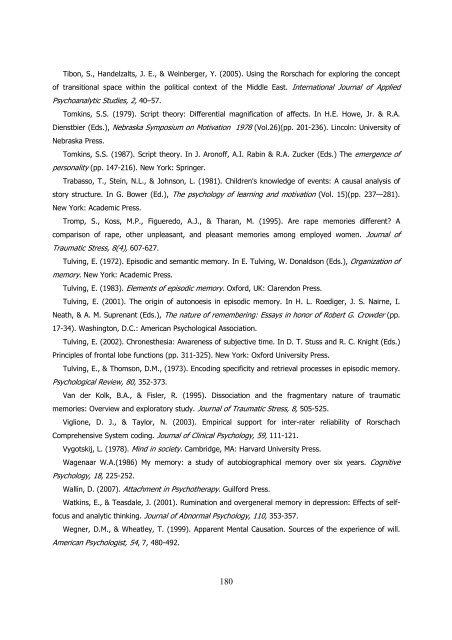LA NARRAZIONE AUTOBIOGRAFICA E IL FUNZIONAMENTO DEL SÉ
LA NARRAZIONE AUTOBIOGRAFICA E IL FUNZIONAMENTO DEL SÉ
LA NARRAZIONE AUTOBIOGRAFICA E IL FUNZIONAMENTO DEL SÉ
You also want an ePaper? Increase the reach of your titles
YUMPU automatically turns print PDFs into web optimized ePapers that Google loves.
Tibon, S., Handelzalts, J. E., & Weinberger, Y. (2005). Using the Rorschach for exploring the concept<br />
of transitional space within the political context of the Middle East. International Journal of Applied<br />
Psychoanalytic Studies, 2, 40–57.<br />
Tomkins, S.S. (1979). Script theory: Differential magnification of affects. In H.E. Howe, Jr. & R.A.<br />
Dienstbier (Eds.), Nebraska Symposium on Motivation 1978 (Vol.26)(pp. 201-236). Lincoln: University of<br />
Nebraska Press.<br />
Tomkins, S.S. (1987). Script theory. In J. Aronoff, A.I. Rabin & R.A. Zucker (Eds.) The emergence of<br />
personality (pp. 147-216). New York: Springer.<br />
Trabasso, T., Stein, N.L., & Johnson, L. (1981). Children's knowledge of events: A causal analysis of<br />
story structure. In G. Bower (Ed.), The psychology of learning and motivation (Vol. 15)(pp. 237—281).<br />
New York: Academic Press.<br />
Tromp, S., Koss, M.P., Figueredo, A.J., & Tharan, M. (1995). Are rape memories different? A<br />
comparison of rape, other unpleasant, and pleasant memories among employed women. Journal of<br />
Traumatic Stress, 8(4), 607-627.<br />
Tulving, E. (1972). Episodic and semantic memory. In E. Tulving, W. Donaldson (Eds.), Organization of<br />
memory. New York: Academic Press.<br />
Tulving, E. (1983). Elements of episodic memory. Oxford, UK: Clarendon Press.<br />
Tulving, E. (2001). The origin of autonoesis in episodic memory. In H. L. Roediger, J. S. Nairne, I.<br />
Neath, & A. M. Suprenant (Eds.), The nature of remembering: Essays in honor of Robert G. Crowder (pp.<br />
17-34). Washington, D.C.: American Psychological Association.<br />
Tulving, E. (2002). Chronesthesia: Awareness of subjective time. In D. T. Stuss and R. C. Knight (Eds.)<br />
Principles of frontal lobe functions (pp. 311-325). New York: Oxford University Press.<br />
Tulving, E., & Thomson, D.M., (1973). Encoding specificity and retrieval processes in episodic memory.<br />
Psychological Review, 80, 352-373.<br />
Van der Kolk, B.A., & Fisler, R. (1995). Dissociation and the fragmentary nature of traumatic<br />
memories: Overview and exploratory study. Journal of Traumatic Stress, 8, 505-525.<br />
Viglione, D. J., & Taylor, N. (2003). Empirical support for inter-rater reliability of Rorschach<br />
Comprehensive System coding. Journal of Clinical Psychology, 59, 111-121.<br />
Vygotskij, L. (1978). Mind in society. Cambridge, MA: Harvard University Press.<br />
Wagenaar W.A.(1986) My memory: a study of autobiographical memory over six years. Cognitive<br />
Psychology, 18, 225-252.<br />
Wallin, D. (2007). Attachment in Psychotherapy. Guilford Press.<br />
Watkins, E., & Teasdale, J. (2001). Rumination and overgeneral memory in depression: Effects of self-<br />
focus and analytic thinking. Journal of Abnormal Psychology, 110, 353-357.<br />
Wegner, D.M., & Wheatley, T. (1999). Apparent Mental Causation. Sources of the experience of will.<br />
American Psychologist, 54, 7, 480-492.<br />
180

















